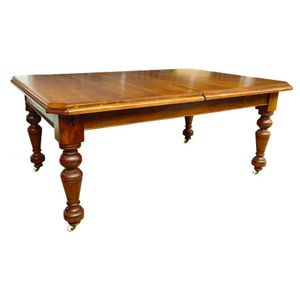Victorian Walnut Extension Dining Table with 3 Leaves
You must be a subscriber, and be logged in to view price and dealer details.
Subscribe Now to view actual auction price for this item
When you subscribe, you have the option of setting the currency in which to display prices to $Au, $US, $NZ or Stg.
- Canted Corners - In decorative arts, especially furniture making, a canted corner refers to a technique where the corner of the piece is angled or "canted" to create a diagonal corner. This is different from a chamfered corner which is a technique where the edges of a corner are cut at an angle, creating a diagonal edge or "bevel" along the corner.
A canted corner is typically used to add visual interest to the item. It can be found in various styles of furniture such as contemporary, Art Deco, or traditional. It is often used to create a sense of movement and dynamism in a piece.
Canting a corner is a more complex technique than chamfering, and it is typically done by tilting the corner of a piece of furniture and then cutting the wood to match the angle. It's a technique that requires precise measurements and a good understanding of angles and geometry, and it is usually done by experienced artisans. - Victorian Period - The Victorian period of furniture and decorative arts design covers the reign of Queen Victoria from 1837 to 1901. There was not one dominant style of furniture in the Victorian period. Designers used and modified many historical styles such as Gothic, Tudor, Elizabethan, English Rococo, Neoclassical and others, although use of some styles, such as English Rococo and Gothic tended to dominate the furniture manufacture of the period.
The Victorian period was preceded by the Regency and William IV periods, and followed by the Edwardian period, named for Edward VII (1841 ? 1910) who was King of the United Kingdom and the British Dominions and Emperor of India for the brief period from 1901 until his death in 1910. - Baluster (furniture) - An architectural term for a column in a balustrade or staircase, often defined as a "vase shape". The shape is extensively used in furniture and decorative arts.
In furniture, it is used to describe a chair or table leg turned in that form, or more usually as an inverted baluster, with the bulbous section to the top. Less commonly used to describe a chair back that has the outline of a baluster. A baluster may also be split and applied to the front of a cupboard for ornamentation.
For ceramics and silver items it is often used to describe the shape of the whole item, rather than a part.
In Georgian glassware, the shape is commonly seen in the stem of glasses.
This item has been included into following indexes:
- tables, large dining
Visually similar items

A Victorian two leaf extension dining table c.1850's, the table has a winding mechanical type action which extends for one or two leaves the legs are bulbous and reeded style with porcelain castors. Height 74 cm. Width 115 cm. Length 235 cm

A colonial kauri banquet extension dining table, the plank top with heavy moulded edge, extending to receive two leaves and seat 12, raised on baluster turned legs with brass and white porcelain casters. 271 x 124.5 x 76.5 cm

Rare West Australian Colonial jarrah dining table, c.1870-1880, maker unknown, the table is a rarer, larger size, which can seat, approximately ten and up to twelve place settings, the top is constructed of two large 'Book-Matched', jarrah boards featuring

A fine specimen table, fiddleback blackwood, cedar and huon pine, Tasmanian origin, circa 1855 drawers fitted with compartments in huon pine with blackwood trim 76 cm high, 62 cm wide, 49 cm deep
